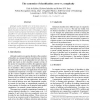Free Online Productivity Tools
i2Speak
i2Symbol
i2OCR
iTex2Img
iWeb2Print
iWeb2Shot
i2Type
iPdf2Split
iPdf2Merge
i2Bopomofo
i2Arabic
i2Style
i2Image
i2PDF
iLatex2Rtf
Sci2ools
ICPR
2002
IEEE
2002
IEEE
The Economics of Classification: Error vs. Complexity
Although usually classifier error is the main concern in publications, in real applications classifier evaluation complexity may play a large role as well. In this paper, a simple economic model is proposed with which a trade-off between classifier error and calculated evaluation complexity can be formulated. This trade-off can then be used to judge the necessity of increasing sample size or number of features to decrease classification error or, conversely, feature extraction or prototype selection to decrease evaluation complexity. The model is applied to the benchmark problem of handwritten digit recognition and is shown to lead to interesting conclusions, given certain assumptions.
Classifier Error | Classifier Evaluation Complexity | Computer Vision | Handwritten Digit Recognition | ICPR 2002 |
| Added | 09 Nov 2009 |
| Updated | 09 Nov 2009 |
| Type | Conference |
| Year | 2002 |
| Where | ICPR |
| Authors | Dick de Ridder, Elzbieta Pekalska, Robert P. W. Duin |
Comments (0)

